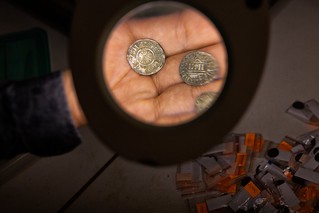
PREV ARTICLE
NEXT ARTICLE
FULL ISSUE
PREV FULL ISSUE
MORE ON FRENCH COINS FOUND IN POLANDLast month we discussed a hoard of silver coins found in Poland and speculated to be part of a ransom to save the city of Paris. Ken Spindler of San Diego passed along this New York Times article on the hoard. Thanks. -Editor
The Vikings — Scandinavian warriors greatly feared because of their unruly habits and military prowess — later systematized what became an elaborate protection racket in the 11th century by imposing taxes in England known as Danegeld, tribute payments in return for safety. What happened to the huge ransom they received for sparing Paris in 845, however, has always been a mystery. The Vikings had a major trading post called Truso just 30 miles from Biskupiec, the Polish village where the coins were found. That has led some experts to speculate that the silver extorted in Paris made its way there and then spread into nearby areas as part of a flourishing Baltic-region trade, whose main commodity was slaves.
Others are skeptical. Simon Coupland, a British expert, noted that the coins found in Biskupiec seemed to date from several years before the 845 siege. But, he added, they could be part of the booty extracted by the Vikings during earlier attacks on the western part of the empire established by Charlemagne, or simply the proceeds of regular trading and raiding by the Vikings.
Mr. Szczepanski acknowledged that his theory that the coins were part of the ransom the Vikings extorted to spare Paris was merely a A clearer picture, he said, would emerge after a chemical analysis of the coins and a full excavation of the site where they were discovered by the local treasure hunter, Przemyslaw Witkowski, and a fellow scavenger, Maciej Malewicz.
To read the complete article, see:
To read the earlier E-Sylum article, see:
Wayne Homren, Editor The Numismatic Bibliomania Society is a non-profit organization promoting numismatic literature. See our web site at coinbooks.org. To submit items for publication in The E-Sylum, write to the Editor at this address: whomren@gmail.com To subscribe go to: https://my.binhost.com/lists/listinfo/esylum All Rights Reserved. NBS Home Page Contact the NBS webmaster 
|

